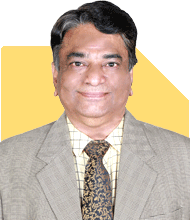Ashwini Dasgupta | Answer |Ask -Follow
Personality Development Expert, Career Coach - Answered on Jul 17, 2023
She has 15 years of experience training corporate professionals and has worked at Amazon, JP Morgan, Nomura and Satyam among others.
As a career coach, Ashwini specialises in helping growth-minded IT corporate managers develop their self-worth and create the right mindset so that they can achieve their career goals.
Besides corporate training, she offers personal consultations as well.
Ashwini holds a master’s degree in human resources from the Narsee Monjee Institute of Management Studies, Mumbai, and is a certified NLP trainer from the National Federation of NeuroLinguistic Programming, USA.
She has completed her soft skills training and image consultancy course from the Image Consulting Business Institute, Mumbai
Ashwini is also a PoSH trainer, certified by the Society for Human Resource Management.... more

I am having more than 22+ experience but not able to get the job, my name is sunil r nair, i am working as a software delivery head, with nothing pay like money, so what should i do to get job with good salary.
Thank you for writing in.
Few tips to get started.
Self-Assessment: Identify your skills, interests, and strengths. It's been 22 years so by far you would have enough clarity what are your strengths and area of interests. We often tend to ignore and take it for granted due to our vast experience. Hence recommendation is to revisit your own strengths and interests.
Polish Your Resume and Cover Letter: Craft a well-written resume and cover letter that highlight your achievements, skills, and experiences. Tailor them to each job application to showcase your suitability for the role. Customize your resume as per the jobs.
Networking: Build a professional network by attending industry events, job fairs, and connecting with people on social media platforms like LinkedIn. Many jobs are found through referrals and personal connections.
Online Presence: Create a strong online presence through platforms like LinkedIn and professional portfolios. Showcase your expertise and share valuable content related to your field.
Job Search Strategies: Utilize various job search platforms, such as online job boards, company websites, and recruitment agencies. Be consistent and diligent in your job search efforts.
Prepare for Interviews: Practice common interview questions and be ready to articulate your skills and experiences confidently. Research the company and the role to demonstrate your interest and knowledge.
Focus on Soft Skills: Apart from technical skills, employers value soft skills such as communication, problem-solving, teamwork, and adaptability. Work on developing and showcasing these skills in interviews and on the job.
Continuous Learning: Stay updated with industry trends and advancements. Participate in workshops, webinars, and seminars to keep improving your skills and knowledge.
Professional Attitude: Demonstrate a positive and professional attitude during your job search and in interactions with potential employers. Be punctual, courteous, and responsive in your communications.
Follow Up: After interviews or submitting applications, follow up with a thank-you email or letter. It shows your interest and appreciation for the opportunity.
Be Open-Minded: Be flexible and open to exploring different job opportunities, especially if they align with your long-term career goals.
As you have been in the industry for 22 + years look at your own networks who could refer and guide you for the right opportunities. Importantly trust yourself and your abilities. Job Search requires patience. You will get there soon.
Hope this helps. All the best.
To Your Success. Be You. Be Confident.
Ashwini Dasgupta
Author of Confidence Decoded. Is it a Skill or Attitude?
You may like to see similar questions and answers below
Mayank Rautela | Answer |Ask -Follow
HR Expert - Answered on Mar 11, 2022
Abhishek Shah | Answer |Ask -Follow
HR Expert - Answered on Jul 04, 2023
Patrick Dsouza |1429 Answers |Ask -Follow
CAT, XAT, CMAT, CET Expert - Answered on Nov 14, 2023
Maxim Emmanuel | Answer |Ask -Follow
Soft Skills Trainer - Answered on Jul 22, 2024
Ramalingam Kalirajan |10908 Answers |Ask -Follow
Mutual Funds, Financial Planning Expert - Answered on Dec 20, 2025
Ramalingam Kalirajan |10908 Answers |Ask -Follow
Mutual Funds, Financial Planning Expert - Answered on Dec 20, 2025
Naveenn Kummar |237 Answers |Ask -Follow
Financial Planner, MF, Insurance Expert - Answered on Dec 20, 2025
Ramalingam Kalirajan |10908 Answers |Ask -Follow
Mutual Funds, Financial Planning Expert - Answered on Dec 19, 2025
Nayagam P P |10859 Answers |Ask -Follow
Career Counsellor - Answered on Dec 19, 2025
Ramalingam Kalirajan |10908 Answers |Ask -Follow
Mutual Funds, Financial Planning Expert - Answered on Dec 19, 2025
Ramalingam Kalirajan |10908 Answers |Ask -Follow
Mutual Funds, Financial Planning Expert - Answered on Dec 19, 2025
Ramalingam Kalirajan |10908 Answers |Ask -Follow
Mutual Funds, Financial Planning Expert - Answered on Dec 19, 2025
Radheshyam Zanwar |6751 Answers |Ask -Follow
MHT-CET, IIT-JEE, NEET-UG Expert - Answered on Dec 19, 2025
Radheshyam Zanwar |6751 Answers |Ask -Follow
MHT-CET, IIT-JEE, NEET-UG Expert - Answered on Dec 19, 2025



























